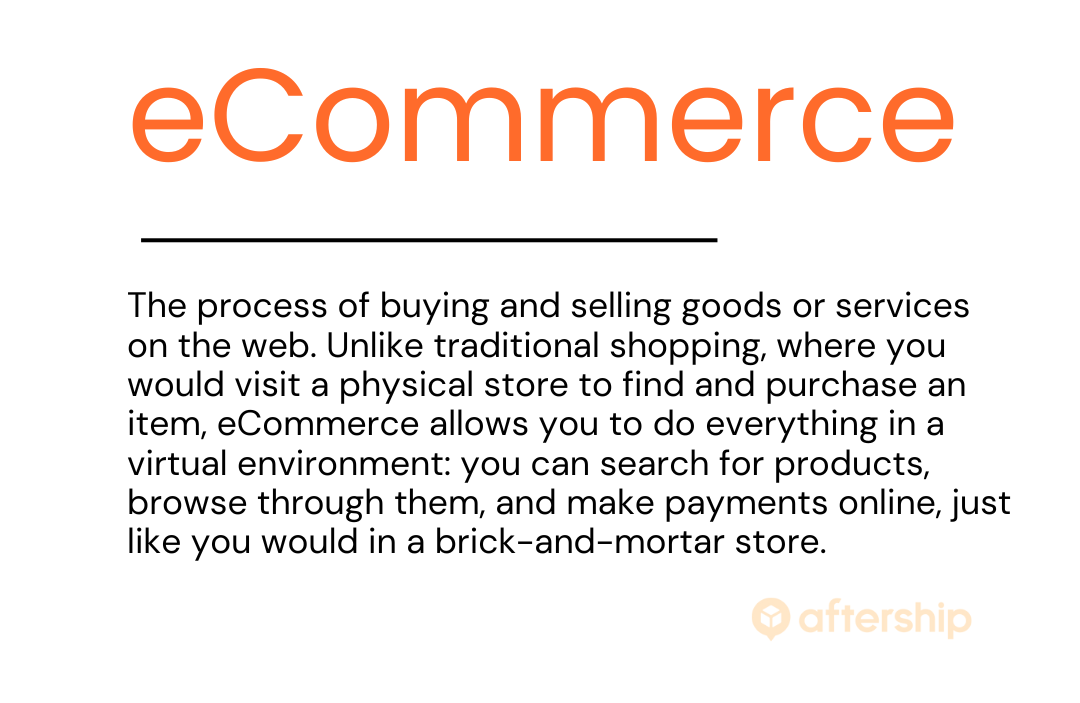What is eCommerce? Everything You Need to Know in 2024

The eCommerce industry has become an indispensable part of global retail sales.
According to Statista, global eCommerce revenue reached an estimated 5.8 trillion U.S. dollars in 2023. It's no surprise that as those numbers skyrocket, more people and businesses are showing an interest in eCommerce and the opportunities associated with it.
If you want to learn more about what eCommerce means and how it works in 2024, this article’s for you. In it, we cover the basics you need to know. We’ll also take a look at some successful online stores—and share a little bit about how they came to be.
What is eCommerce?
eCommerce (or electronic commerce) is the process of buying and selling goods or services on the web. Unlike traditional shopping, where you would visit a physical store to find and purchase an item, eCommerce allows you to do everything in a virtual environment. You can search for products, browse through them, and make payments online, just like you would in a brick-and-mortar store.

But from a purely transactional standpoint, here’s how eCommerce works:
Step 1: The customer places an order.
The first step is customers ordering through a website (online store or marketplace).
Step 2: Retailer processes order information.
In the next step, the storeowner processes payment information and prepares the item for delivery.
Step 3: The order is shipped to the customer.
The last step is where product shipping is carried out. All the logistics elements— from product handling to information and control —play an essential role in ensuring successful delivery to the customer.
If you get the basics right and find ways to reduce friction at each step, you are more likely to be successful.
Types of eCommerce Businesses
You can categorize eCommerce businesses based on the type of products or services they sell online. Here’s a look at the most common types of merchants:
1. Digital Products Retailers
These merchants sell digital products online. Some examples of e-goods include graphics, white papers, studies, reports, e-books, software, and music downloads. Digital goods are essentially data-based and non-physical, meaning inventory management is no longer a concern.
Some examples of eCommerce stores that sell digital products include:
- The Lux Lens: An online store that sells tools and online courses for photographers.
- Life is Messy and Brilliant: An online store that sells digital planners and digital stickers for event planners.
2. Stores Selling Physical Goods
These merchants follow the typical online retail business model. From swimsuits to sportswear and office equipment, shoppers can add what they need to their online cart and buy it (usually with a credit card). Afterward, the store delivers the product directly to the customer.
Some online retailers use dropshipping for order fulfillment. This is a fulfillment method where the merchant purchases the product from a third-party supplier and gets it shipped directly to the customer. Dropshipping removes the need to buy or stock inventory, making inventory management and supply chain issues less burdened. In recent years, it's become a trendy type of model for small business because it allows the business owner to focus their efforts on marketing, customer service, and online advertising.
Some examples of stores that sell physical products include:
- Outerknown: An online store that sells men’s, women’s, and sustainable apparel
- iTech Deals: An online store that sells iPads, Macbooks, Chromebooks, and tech accessories
- Helix Sleep: An online store that sells mattresses, bedding, and bed frames
3. Service-Based E-Tailers
Service-based e-tailers sell services online. They may sell services through an online store or platform, a subscription-based model, or send you an invoice in exchange for services rendered.
For instance, contractors, consultants, and freelancers that sell services online are considered service-based e-tailers. SaaS (software-as-a-service) companies, language learning platforms, and freelance marketplaces are also considered to be service-based e-tailers if they charge on a subscription model.
Some specific examples of service-based e-tailers include:
- Contena: An online platform that sells tools, training modules, and job search services for content writers.
- Donut: A subscription-based app that helps teams discover new rituals that foster camaraderie, collaboration, and community.
- Preply: An online language learning platform that pairs students with private tutors.
What Is an eCommerce Website?
An eCommerce website is a virtual storefront facilitating transactions via funds and data transfer over the Internet. Since this depends on electronic data interchange, it must use a platform, database, and payment gateway to function effectively. Security features are also table stakes.
Types of Websites Used for Selling
eCommerce websites can be classified by the business model they use to carry out operations. Typically, stores fall into one of the following categories.
1. Business to business (B2B)
In this model, an eCommerce store sells products and/or services to another business. For instance, Chocomize sells customized chocolates and corporate gifts to companies looking to express their gratitude for their clients.
2. Business to consumer (B2C)
In B2C, an eCommerce business sells products and/or services directly to consumers. An excellent example of this is Nearly Natural. The artificial floral retailer sells plants, flowers, and baskets directly to the end customer, with no middle person involved in the process. This form is sometimes also referred to as DTC, meaning "direct to consumer," though hybrid models have also become popular among retail companies after the high-profile struggles of some strictly DTC brands in the 2010s.
3. Consumer to consumer (C2C)
In C2C eCommerce, a consumer sells a good and/or service to another consumer. One individual may use a marketplace platform like eBay or Etsy to sell or auction goods to another person. Online auctions have remained a popular way of selling goods between consumers.
4. Consumer to business (C2B)
In C2B eCommerce, a consumer sells a product and/or service to a business or organization. For instance, a person who sells their car to Carvana, an automotive company, would be engaging in C2B eCommerce.
5. Consumer to government (C2G)
C2G eCommerce happens when consumers pay bills, insurance, or taxes online to a government or public entity. For instance, if you get your water from the city, you engage in C2G every time you pay your water bill online. For security reasons, government agencies were often slower to adopt electronic payments, but now online transactions are relatively standard.
Want some additional insights into eCommerce? We recommend the following resources:
- A 3-Phase Beginner’s Guide: How to Start an eCommerce Business
- How to Build a DTC Marketing Strategy
- eCommerce Marketing: 20 Ways to Supercharge Your Sales
- How to Choose the Right Returns Software for Your eCommerce Business
What Are The Best eCommerce Platforms?
This depends on the type of online business you run, your customers and marketing strategies, and the resources at your disposal. Starting a business requires building an online store where you showcase your products or services. This is done with the help of an eCommerce platform that allows you to manage your website, sales, and operations. Popular eCommerce platforms include:
- Shopify: Offering exceptional ease of use and extensive functionality, Shopify allows you to sell physical products and services. You can access themes built specifically for your industry. Features range from inventory tracking to AI personalization. Shopify also has a robust App Store where you can find add-ons for dropshipping, SEO, email marketing, and more.
- WooCommerce: This is a free, open-source shopping cart add-on for WordPress users. WooCommerce makes it easy to implement various third-party themes and plugins, access a mobile-optimized shopping cart, and geolocation support.
- Magento: A leading open-source platform, Magento is a popular pick for companies with established demand. There are more than 5000 extension options to choose from and various options for customization, but Magento requires more insight from developers. This platform for global selling also comes with site search functionality, catalog management, and one-click purchase.
- Shopify Plus: The B2B version of Shopify, Shopify Plus allows enterprise companies to sell vast amounts of products and services to bigger buyers. Shopify Plus has the same ease of use as the original Shopify software. Yet, it’s stocked with features suitable for large-volume sellers, from unlimited product listings to inventory tracking and real-time product statistics.
Examples of Successful Stores
The world of eCommerce has seen countless success stories. That’s because the effort required to ramp up a virtual storefront and build a business around it is often much easier than it used to be—certainly more so than a traditional physical storefront. (Plus, while market research is a challenge for traditional brick-and-mortar, even small eCommerce stores often have instant access to customer data to drive marketing campaigns and optimize checkout.)
Here are some successful retailers that might inspire you:
Premier Estates Wines
Budge Dhariwal, the founder of Premier Estates Wines, was once a taxi driver who craved a career change.
His first step? Picking up an off-license to become an independent wine retailer.
The problem? He couldn’t keep up with supermarkets during holidays and special events.
So he decided to sell his off-license and start a wine company instead.
Budge spoke with anyone he could about his wine company. He then decided to fly around Europe on cheap flights to approach major wineries about supplying his independent company with wine.
The good news? It worked.
Today, Premier Estates Wine is an online wine company that sources award-winning wines and sells them at low prices.
By leveraging partnerships and building positive customer experiences, Budge built one of Shopify’s most renowned stores.
Brilliant Life Shop
Brilliant Life Shop was created by mompreneurs Beth Anne Schwamberger and Sarah Korhnak.
During their weekly podcast series, Beth and Sarah interviewed a different mompreneur each week. After surveying their audience about common challenges they face, their community said time management was their biggest challenge.
The result? Beth and Sarah co-wrote a successful book, Time Management Mama: Making Use of the Margins to Pursue Your Passions. They also created a time management planner and built valuable resources for their community.
Today, Beth and Sarah’s community is closer than ever. Their online store Brilliant Life Shop provides guides, resources, courses, and their book for fellow mompreneurs.
By creating high-quality content and focusing on giving their audience exactly what they wanted, Beth and Sarah were able to create the store of their dreams.
Frequently Asked Questions About eCommerce
What does eCommerce mean?
eCommerce stands for "electronic commerce."
How many people use eCommerce worldwide?
Different sources provide different answers, but according to a recent forecast by eMarketer that number stands at 2.71 billion online buyers as of 2024.
What is the biggest eCommerce company in the world?
Amazon remains the world’s biggest eCommerce company, with an estimated market cap of U.S. $1.85 trillion as of March 2024.
What percentage of eCommerce is mobile?
According to Oberlo, mobile sales are projected to hit 3.4 trillion U.S. dollars by 2027. Also, mobile is expected to account for 60 percent of total eCommerce sales by the end of the year, including social commerce through apps like Instagram and TikTok.
How the heck do you capitalize eCommerce?
eCommerce, e-commerce, and ecommerce are all popular ways to spell the term. People rarely spell it consistently, however, and even large companies like Shopify sometimes slip between them. Many dictionaries and style guides prefer e-commerce, but linguistics data shows that in actual use, spellings without hyphens are rapidly becoming more popular. As with "email" vs. e-mail, it's likely the hyphenated term will go the way of the dinosaur.
Whatever you do, through, try to be consistent. At AfterShip, we use eCommerce.
What is eCommerce shopping?
eCommerce online shopping is the act of buying goods and/or services online.
Here are some common examples of eCommerce shopping:
- Signing up for a monthly subscription service for movies, music, or software
- Buying your boss’ Christmas present from an online marketplace
- Paying for food delivery using an online platform or app
- Buying your clothes, accessories, and groceries online
- Using a website or platform to buy airline tickets, hotel accommodations, and rent a car
eCommerce: It’s a Wonderful Thing
If you’ve been interested in learning more about eCommerce, we hope this guide was just what you needed.
Digesting all of that information may get your heart pumping. But when you’re building an eCommerce store from the ground up, the learning and insight help you create an excellent structure and set the store up for success.

